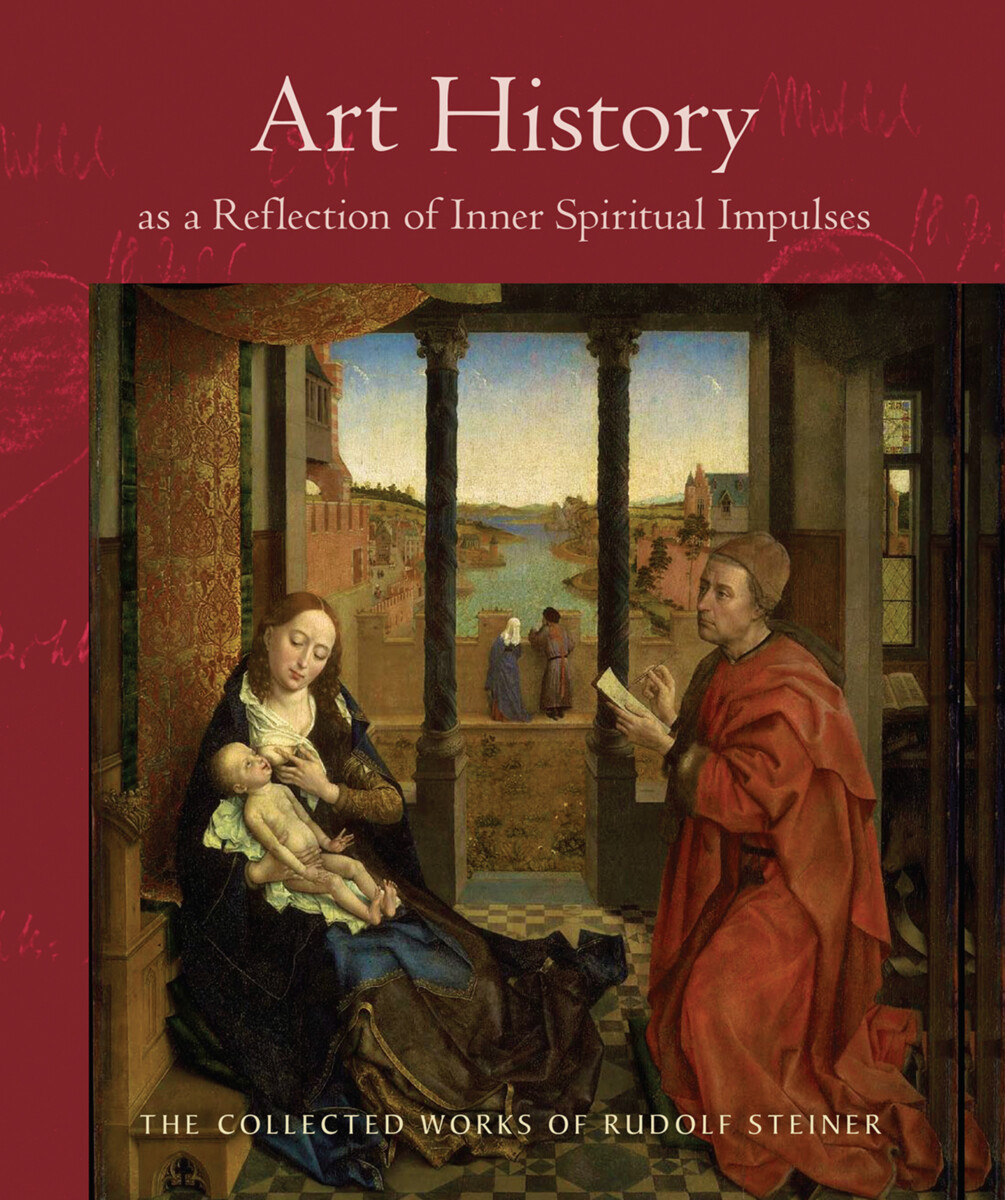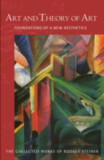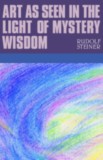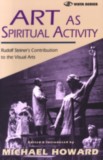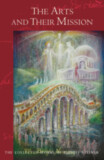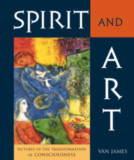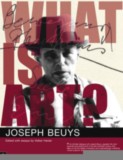Art History as a Reflection of Inner Spiritual Impulses
(CW 292)
- Publisher
SteinerBooks - Published
1st June 2016 - ISBN 9780880106276
- Language English
- Pages 432 pp.
- Size 7.5" x 9"
- Images Color
13 slide presentations, Dornach, October 8, 1916 – October 29, 1917 (CW 292)
"I am going to show you a series of reproductions, of slides, from a period in art history to which the human mind will probably always return to contemplate and consider; for, if we consider history as a reflection of inner spiritual impulses, it is precisely in this evolutionary moment that we see certain human circumstances, ones that are among the deepest and most decisive for the outer course of human history, expressed through a relationship to art." — Rudolf Steiner
Rudolf Steiner understood that the history of art is a field in which the evolution of consciousness is symptomatically and transparently revealed. This informal sequence of thirteen lectures was given during the darkest hours of World War I. It was a moment when the negative consequences of what he called the age of the consciousness soul, which began around 1417, were made most terribly apparent. In these lectures he sought to provide an antidote to pessimism. After describing the movement of consciousness from Greece into Rome, coupled with influences from the Orthodox East, he showed how these influences transformed as the Middle Ages became the Renaissance.
The process that begins with Cimabue and Giotto develops, deepens, and becomes more conscious in the great Renaissance masters Leonardo, Michelangelo, and Raphael. Then this movement continues with the Northern masters, Dürer and Holbein, as well as the German tradition. One entire lecture is devoted to Rembrandt, followed by one on Dutch and Flemish paintings. Themes are woven together to show how past epochs of consciousness and art live again in our consciousness-soul period.
Replete with interesting information and more than 600 color and black-and-white images, these lectures are rich and dense with ideas, enabling us to understand both the art of the Renaissance and the transformation of consciousness it announced. These lectures demonstrate (to paraphrase Shelley) that artists truly are the unacknowledged legislators of the age.
Art History as a Reflection of Inner Spiritual Impulses is a translation from German of Kunstgeschichte als Abbild innerer geistiger Impulse (GA 292, Rudolf Steiner Verlag, 2000).
CONTENTS & SYNOPSES:
Introduction: “Art and a Beyond” by Stephen Keith Sagarin, PhD
1. Cimabue, Giotto, and Other Italian Masters
(Dornach, October 8, 1916)
The transformation of human consciousness in the art of the Renaissance, which developed gradually during the transition from the fourth to the fifth post-Atlantean age: Cimabue, Giotto, and other Italian Masters. Up to the second millennium of the Christian era, what was important was calling up powers of imagination capable of rending the suprasensory perceptible to the senses. The form of the Redeemer develops in Greece. The artistic approach fructified by Eastern powers of imagination is then transplanted to Italy. The art of Cimabue: visionary glimpses of a supra-earthly world. With Giotto comes a new understanding of the world and an inner soul connection with Francis of Assisi who introduces a material way of feeling imbued with soul. The basic character of the fifth post-Atlantean era is to live within earthly, material reality. Giotto displays empathy through the processes of growth and development in nature with an inherent Platonic element. Then something theological and Aristotelian enters into human feeling—the tendency to categorize, to be allegorical. We see a three-level composition: The Rule of the Church (School of Giotto). Raphael’s Disputa. A dual stream: the individualizing realistic element emancipates itself from the spiritual element. Masaccio, Ghirlandaio: the spiritual is depicted naturalistically; Fra Angelico, Botticelli: the soul is depicted naturalistically; allegory: Camposanto, Traini; composition: Perugino and others. All elements come together in the mastery of the human element by the great masters of the Renaissance. Leonardo’s Last Supper and Raphael’s St. Cecilia.
2. Leonardo – Michelangelo – Raphael
(Dornach, November 1, 1916)
The three great figures of the Renaissance mark the beginning of a new age in the arts, and at the same time sum up the era that has gone before. Different from modern artists, their creative work arises from the whole cultural life of their period. Leonardo still lives in the earlier period in his consciousness, but he seeks to go beyond, from a feeling for nature (St. Francis) to understanding it. He goes far beyond his time in the application of the forces of nature. Michelangelo is very much a part of the political life of the time; he brings Florence to Rome, and later lives through the change in Florence, where commercial interests supersede the sacramental aspect. The Last Judgment in the Sistine Chapel marks his protest. Raphael, with the tender view of nature and humanity he has developed in Urbino, brings an element of Christian art into the age in which he lives. The way in which popes and princes work with the artists reflects the necessary tragedy in human history that comes to expression in one-sided developments.
3. German Sculpture and Painting to the Time of Dürer and Holbein
(Dornach, November 8, 1916)
In contrast to the Southern impulse of imagination, rooted in seeing the resting form and the compositional element, imagination catches on to the events in the North, catches on to movement reflecting human activity, and to the sign in which the human soul lives. The miniatures in the missals mark a natural transition from the sign, to the word, to image quality. Imagination based on the will impulse spreads from the Northern to the Southern contemplative impulse. Leonardo’s Last Supper serves as an example. In the West, an impulse for practical life coming from the North combines with a mystical element from Spain and the South of France. In Central Europe, the will element rebels against the Romanesque, and also the Gothic, favoring individual expression of the inner life. The color contrast to the South and also in Central Europe. The magic element of chiaroscuro shows the connection that exists between human beings and the naturalistic elemental nature. Dürer, as a unique figure in this Central European development. Romanesque and Central European impulses come together in the sculptures at Naumburg, Strasbourg, etc., and in the work of the Masters of Cologne, from Stephan Lochner to Gruenewald. Dürer, as the outstanding artist in Central Europe. Compositions are born from light and darkness. Holbein, on the other hand, is a realist of the external world.
4. Sculpture of Germany and the Netherlands
(Dornach, November 15, 1916)
The northern and central European art of the mobile inner element. Modern views in art focus on the novelty aspect, lacking insight into the specifically artistic. Art develops a life of its own, separate from cultural life in general. In Central Europe, the Christian element comes to be at home in the feeling element. Southern Renaissance art seeks to bring out beauty in Christian figures; central European artists enter with feeling into the Passion, into its tragic and dramatic elements. A quiet, undramatic deepening of the inner life gives expression to it in the arts, and continues from the thirteenth to the sixteenth centuries, culminating in Dürer’s works on the Passion. The Byzantine Christ has been superhuman; Dürer’s Christ shows human inwardness. Raphael takes his subjects beyond the human level. Van Eyck takes humanity to a deeper level. Crucifixion groups show that the story of the Passion has entered wholly into Central European souls even at the beginning of the thirteenth century. In Southern art the garments relate to the human body; in Central European art they appear more as a continuation of the inner life. A deeper inner life comes to expression in the way that figures relate to one another—Mary and John, as well as other biblical figures. There is an interaction between temporal and religious elements—Ecclesia and Synagogue; the Bamberg Horseman. Individualism in Claus Sluter’s sculptures at Dijon in the early fourteenth century. Comparison of Sluter’s Moses with the one created by Michelangelo a century later. Developments in Germany up to Riemenschneider and Stoss. The painter Hans Baldung Grien, at the same time as Raphael and Michelangelo in Rome, is just one example of the cultural change as consciousness soul development takes over from that of the intellectual soul.
5. Rembrandt
Dornach, November 28, 1916)
An inadequate attempt is made by a German author to show the importance for nineteenth century culture to gain new insight into Rembrandt. This is possible only by going much more deeply into his origins in Central European life. In a unique personal achievement, individualism and freedom emerge in a process largely independent of contemporary history. Rembrandt is wholly an artist of the fifth post-Atlantean age, approaching his subjects entirely from the outside, but bringing light into it. Life and activity in 3-dimensional space are recreated in chiaroscuro, with color born from this. Rembrandt’s originality lies in the spiritual greatness of his forms. The death of his wife Saskia affects Rembrandt’s life deeply, yet it also leads to deepening in his inner life and greatness as an artist. Progressive development seen from one 5-year period to another. The two major elements are his working directly from the Bible and not from legend, and his self-portraits, in which he seeks to show the connection between inner life and observation of the outside world. Rembrandt’s etchings rank equally with his paintings.
6. Dutch and Flemish Painting
(Dornach, December 13, 1916)
The development of painting in the Netherlands allows detailed study of the influence of the consciousness soul. Paintings are characteristically presented from the beholder’s viewpoint. The treatment of three-dimensional space evolves in stages, with Brunelleschi in particular making it subject to strict perspective. In the South, the compositional element is perfected in the way groups are shown in perspective. In the North, artists seek to bring individual soul quality to the surface by using color in flowing light. The paintings of the van Eycks are the starting point for naturalism in the art of North and Central Europe. This is the time when individual city-states arise. The civic virtues of the North and the Netherlands enter into the aristocratic element of the South. The Ghent Altarpiece exemplifies the way in which individualism comes into its own within traditional Christian ideas. French influences, but the example of the van Eycks continues. New elements gradually flow into this, with the influence of the South in the sixteenth century.
7. Christmas Themes through the Centuries
(Dornach, January 2, 1917)
The art of the early Christian centuries evolves into representations of spiritual Imaginations and finally, during the Renaissance, into a naturalistic view of progressively more human biblical figures. Themes of Nativity and Adoration of the Shepherds relate to Luke’s gospel; they could well be understood by a consciousness influenced by the mysteries of the North. Themes of Adoration of the Kings and Flight to Egypt relate to Matthew's gospel; understanding the mission of the magi calls for a Gnostic insight, which can now only be regained with the help of spiritual science. It is characteristic of the works in both groups that earlier paintings show events in connection with the spiritual world, removed from any kind of naturalism. Later the naturalistic element gradually brings a more intimate soul quality. The traditional aspect is more dominant in the South, the individualistic aspect in the North.
8. Raphael – Dürer, and the German Masters
Dornach, January 17, 1917
Behind Raphael stand the great worldviews that evolve at the end of the fourth post-Atlantean era. Cosmic laws influence his work, which progress in four-year cycles. Raphael’s work as the culmination of that tradition. German masters of the period seek to give immediate expression to the quality of soul. With Dürer, Central European life forms the background and the freedom of city-states as it moves toward the Reformation. His works show the elementary quality arising in the human soul. Examples from his Apocalypsis show the inwardness of his Passions. Preoccupation with the phenomenon of death reflects consciousness soul development by being bound up with the physical plane: The Dance of Death. Moser and Multscher are typical examples of the problem of reconciling the laws of perspective, etc., coming from the Southern tradition, with one’s own inner life and feelings. The beginnings of chiaroscuro-based perspective are exhibited by Swabian painters. The original natural gifts of the Germans, that show themselves in a more inward way of making Christianity their own, are reflected in images created out of heart and mind.
9. Greek, Roman, and Renaissance Sculpture
(Dornach, January 24, 1917)
“Working the way nature does,” which is Goethe’s view of Greek art in the fourth post-Atlantean age, becomes with him, a representation of the fifth post-Atlantean age. His study of the laws behind world evolution leads to his discovery of the archetypal plant and theory of metamorphosis. Goethe’s endeavor to see the spirit as it lives in nature makes him sense that, even in the poor reproductions of Greek sculptures available, the invisible element active in the human life body is being represented. It is something which the artist is aware of within himself, and not in the outer form. Working from a model only becomes possible in the fifth age. The evolution of Greek sculpture progresses from a full grasp of the living body, with the human form marvelously taken to the level of the divine, to endeavors to create a more faithful representation of natural forms. Earlier works are very much at rest, later ones full of movement and drama. In the fourth century BCE, the forms of the gods also assume human form in art. A late work such as the Laocoön Group from the first century BCE still bears witness of an awareness of the etheric—the physical and etheric bodies come apart at the moment of death. Roman civilization initially means decline in the twelfth and thirteenth centuries however, the rediscovery of Greek works of art occurs. Pre-Renaissance artists progressively connect the elements gathered from antiquity with the naturalism of the fifth post-Atlantean age. Christian motifs thus achieve perfection of form. The period of Renaissance art is in preparation.
10. Raphael’s Disputa and School of Athens
(Dornach, October 5, 1917)
In its time, in the sixteenth century, the consciousness revealed in Raphael’s Disputa is a profound truth. His paintings mark the conclusion of the imaginative vision that developed in the Christian world from the ninth century on. The rediscovery of America, the invention of the art of printing, and Copernicanism bring a completely new image of the world. The substance of Raphael’s art is no longer directly accessible to human minds. This is a historical necessity—European humanity has to hold back spiritual ideas in order to develop its own civilization; a separation into the Greek, Eastern, and Roman Catholic churches occurs. Spiritual impulses are pushed back onto the East. In the West, the wish is to establish the realm of Christ as a kind of empire. Pope Julius II still sees this realm as a sign for the reality existing in the spiritual world. Raphael belongs to the fifth post-Atlantean age and is depicting, as it were, the protest of the fourth age against the emptiness that comes with the evidence of the senses of people like Luther, who is diametrically opposed to him. The rich colors and forms in Raphael’s imaginations, a testament of the South, are superseded by the formless, unconfigured musical element of the North. Southern elements are pushed back. In contrast to the infinite perspective of the Disputa, the figures in the School of Athens are gathered in an enclosed space—the divine, on the one hand, and the qualities that can live in the human soul, on the other. The contrast arises between the visionary and the speaker as central figures. The figure of Paul is a problem for Raphael—the moving from vision to speech.
11. Icons – Miniatures – German Masters
(Dornach, October 15, 1917)
The major change at the beginning of the fifteenth century was long in preparation. The time of Charlemagne’s reign, about 800 BCE, has great historical significance. The popes take control of Europe; Central European imperialism goes hand in hand with this. The contrast between artistic elements pushed back onto the East and the arts in Southern Europe and Central Europe: Icons and Raphael’s image of the Virgin. Certain elements arise from the souls of the nations themselves. In the northern regions this takes the form of the Song of the Nibelungs, of the Heliand, and then in the work of Walter von der Vogelweide. Art calls for expression to be given to events, but artists feel bound by the rules of tradition coming to Central Europe from the South. The struggle between the two impulses is evident in the miniatures, in the decorated initials in Holy Writ. City culture provides the strength needed to represent the individual aspect. In the Masters of Cologne, traditional art combines with the urge to represent events. The two impulses are further apart in southern Germany (Tiefenbronn and Sterzing Altars). Two aspects of the process can be observed at that time—one brings Eastern elements from the South, the other arises from the depths of the nation’s soul itself.
12. Early Christian Sculpture, Symbols, and Sarcophagi – Precious Metal Works
(Dornach, October 22, 1917)
Echoes from the third and fourth post-Atlantean ages extend into our fifth post-Atlantean age. The characteristic of the fourth post-Atlantean age is representation of things perceptible to the senses as being filled with spirit— the human form in three-dimensional beauty. Christianity counters the artistic representation of living growth with “signs” representing death, taking up the impulses of the third age grown inward. On the one hand, the statuette of The Good Shepherd is Greek in conception, and on the other hand, it is the representation of death, clumsily so at first. The free-standing Greek figure is no longer free, but now is part of a composition. In early Christian sarcophagus reliefs, the composition presents “signs” that become progressively symbolic. A monogram of the Christ with plant and animal motifs appears. In the Egyptian culture of the third post-Atlantean age, the priests received revelations of the Word from above, as did the priests casting runes in the North. The reliefs on sarcophagi, carved ivories, etc., combine naturalism with this sign element. The magic of the sign— the suprasensory plays into the sensual; the Church uses it as such. The magic of gold and precious stones, which come from below ground, as signs. The work in gold and precious stones in the evolving culture of the city. The mystery of gold in the Nibelungs legend. New insight is needed of the mystery of gold as filled with the Christ impulse; this is something we are to learn from evolution in the arts when it is approached with spiritual insight.
13. The Representation of Christ in Art: From Early Christian Art to Rudolf Steiner
(Dornach, October 29, 1917)
Christ has been represented in the arts since the gospels were completed, beginning in the second and third centuries. The Christ monogram is placed among figures from the art of antiquity. Pagan images are used to depict scenes from the gospels, with Christian ideas linked to pagan myths. An example is The Good Shepherd. A pagan characteristic: The human body is penetrated by universal soul quality. The last form of cosmic and universal art may be found in ancient Greece, with the individual human element represented in satyrs. The development of the Christ representation in the West is for a long time dominated by the cosmic and the general, although the individual human element plays into it. The Roman tendency toward a cosmic element becoming abstract does not let that element take root until the time of Cimabue. With Giotto, that element shimmers through in the spiritual and cosmic. With Fra Angelico, a Western, Catholic element comes to the fore. Later, Greek aspects appear again as the Renaissance develops. In the North, with Dürer, one sees no cosmic element at all, but the human being in Christ. A new approach is made by Rudolf Steiner with the group sculpture for the Goetheanum.
Notes
Rudolf Steiner’s Collected Works
Significant Events in the Life of Rudolf Steiner
General Index
Index of Paintings
Rudolf Steiner
Rudolf Steiner (b. Rudolf Joseph Lorenz Steiner, 1861–1925) was born in the small village of Kraljevec, Austro-Hungarian Empire (now in Croatia), where he grew up. As a young man, he lived in Weimar and Berlin, where he became a well-published scientific, literary, and philosophical scholar, known especially for his work with Goethe’s scientific writings. Steiner termed his spiritual philosophy anthroposophy, meaning “wisdom of the human being.” As an exceptionally developed seer, he based his work on direct knowledge and perception of spiritual dimensions. He initiated a modern, universal “spiritual science” that is accessible to anyone willing to exercise clear and unbiased thinking. From his spiritual investigations, Steiner provided suggestions for the renewal of numerous activities, including education (general and for special needs), agriculture, medicine, economics, architecture, science, philosophy, Christianity, and the arts. There are currently thousands of schools, clinics, farms, and initiatives in other fields that involve practical work based on the principles Steiner developed. His many published works feature his research into the spiritual nature of human beings, the evolution of the world and humanity, and methods for personal development. He wrote some thirty books and delivered more than six thousand lectures throughout much of Europe. In 1924, Steiner founded the General Anthroposophical Society, which today has branches around the world.


